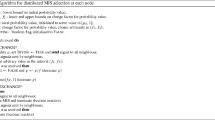Abstract
Finding large (and generally maximal) independent sets of vertices in a given graph is a fundamental problem in distributed computing. Applications include, for example, facility location and backbone formation in wireless ad hoc networks. In this paper, we study a decentralized (or distributed) algorithm inspired by the calling behavior of male Japanese tree frogs, originally introduced for the graph-coloring problem, for its potential usefulness in the context of finding large independent sets. Moreover, we adapt this algorithm to directly produce maximal independent sets without the necessity of first producing a graph-coloring solution. Both algorithms are compared to a wide range of decentralized algorithms from the literature on a diverse set of benchmark instances for the maximal independent set problem. The results show that both algorithms compare very favorably to their competitors.





Similar content being viewed by others
Notes
Note that, for simplicity and without loss of generality, natural numbers greater than zero are used to uniquely identify colors.
Note that although in these graphs the nodes have spatial coordinates, these have not been used to plot the graph. Indeed, all the graphs in the figure have been created using the ‘neato’ layout of the dot software.
References
Afek, Y., Alon, N., Barad, O., Hornstein, E., Barkai, N., & Bar-Joseph, Z. (2011). A biological solution to a fundamental distributed computing problem. Science, 331, 183–185.
Aihara, I., Kitahata, H., Yoshikawa, K., & Aihara, K. (2008). Mathematical modeling of frogs’ calling behavior and its possible application to artificial life and robotics. Artificial Life and Robotics, 12(1), 29–32.
Blum, C., Blesa, M. J., & Calvo, B. (2014). Can frogs find large independent sets in a decentralized way? Yes they can!. In: M. Dorigo, M. Birattari, S. Garnier, H. Hamann, M. A. Montes de Oca, C. Solnon, & T. Stützle (Eds.), Proceedings of ANTS 2014–9th international conference on swarm intelligence, lecture notes in computer science (Vol. 8667, pp. 74–85). Berlin:Springer.
Bui, M., Butelle, F., & Lavault, C. (2004). A distributed algorithm for constructing a minimum diameter spanning tree. Journal of Parallel and Distributed Computing, 64(5), 571–577.
Csardi, G., & Nepusz, T. (2006). The igraph software package for complex network research. InterJournal, Complex Systems, 1695(5), 1–9.
Dijkstra, E. W. (1974). Self-stabilizing systems in spite of distributed control. Communications of the ACM, 17(11), 643–644.
Erciyes, K. (2013). Maximal independent sets. In: Distributed graph algorithms for computer networks, (Chap. 10, pp. 135–156). London:Springer.
Erciyes, K., Dagdeviren, O., Cokuslu, D., Yilmaz, O., & Gumus, H. (2011). Modeling and simulation tools for mobile ad hoc networks. In: J. Loo, J.L. Mauri, J.H. Ortiz (Eds.) Mobile ad hoc networks: Current status and future trends, (Chap. 3, pp. 37–70). Boca Raton, FL:CRC Press.
Erciyes, K. (2013). Distributed graph algorithms for computer networks. Computer communications and networks. London: Springer.
García, S., Fernández, A., Luengo, J., & Herrera, F. (2010). Advanced nonparametric tests for multiple comparisons in the design of experiments in computational intelligence and data mining: Experimental analysis of power. Information Sciences, 180(10), 2044–2064.
García, S., & Herrera, F. (2008). An extension on “statistical comparisons of classifiers over multiple data sets” for all pairwise comparisons. Journal of Machine Learning Research, 9, 2677–2694.
Garey, M. R., & Johnson, D. S. (1979). Computers and intractability: A guide to the theory of NP-completeness. New York, NY: W. H. Freeman.
Guellati, N., & Kheddouci, H. (2010). A survey on self-stabilizing algorithms for independence, domination, coloring, and matching in graphs. Journal of Parallel and Distributed Computing, 70(4), 406–415.
Halldórsson, M. M., & Radhakrishnan, J. (1997). Greedy is good: Approximating independent sets in sparse and bounded-degree graphs. Algorithmica, 18, 145–163.
Hernández, H., & Blum, C. (2012). Distributed graph coloring: An approach based on the calling behavior of japanese tree frogs. Swarm Intelligence, 6(2), 117–150.
Hernández, H., & Blum, C. (2014). FrogSim: Distributed graph coloring in wireless ad hoc networks—An algorithm inspired by the calling behavior of Japanese tree frogs. Telecommunication Systems, 55(2), 211–223.
Ikeda, M., Kamei, S., & Kakugawa, H. (2002). A space-optimal self-stabilizing algorithm for the maximal independent set problem. In: Proceedings of PDCAT 2002—Third international conference on parallel and distributed computing, applications and technologies, pp. 70–74.
Jensen, T. R., & Toft, B. (2011). Graph coloring problems, discrete mathematics and optimization (Vol. 39). Hoboken, NJ: Wiley.
Karp, R. M. (1972). Reducibility among combinatorial problems. Complexity of Computer Computations, 40(4), 85–103.
López-Ibáñez, M., Dubois-Lacoste, J., Stützle, T., & Birattari, M. (2011). The \({\sf irace}\) package, iterated race for automatic algorithm configuration. Technical Report TR/IRIDIA/2011-004, IRIDIA. Université Libre de Bruxelles: Belgium.
Online scientific news site ScienceDaily: Frog calls inspire a new algorithm for wireless networks (2012). http://www.sciencedaily.com/releases/2012/07/120717100123.htm
Scott, A., Jeavons, P., & Xu, L. (2013). Feedback from nature: An optimal distributed algorithm for maximal independent set selection. In: P. Fatourou & G. Taubenfeld (Eds.), Proceedings of PODC 2013—ACM symposium on principles of distributed computing, (pp. 147–156). New York, NY:ACM Press.
Shukla, S. K., Rosenkrantz, D. J., & Ravi, S. S. (1995). Observations on self-stabilizing graph algorithms for anonymous networks. In: Proceedings of WSS 1995—The second workshop on self-stabilizing systems, 16 pages.
Turau, V. (2007). Linear self-stabilizing algorithms for the independent and dominating set problems using an unfair distributed scheduler. Information Processing Letters, 103(3), 88–93.
Acknowledgments
This work was supported by Projects TIN2012-37930, TIN2013-41272P and TIN2007-66523 of the Spanish Government, and Project 2009-SGR1137 of the Generalitat de Catalunya. In addition, support is acknowledged from IKERBASQUE (Basque Foundation for Science) and the Basque Saiotek and Research Groups 2013-2018 (IT-609-13) programs. Our experiments have been executed in the High Performance Computing Environment managed by RDlab (http://rdlab.lsi.upc.edu), and we would like to thank them for their support.
Author information
Authors and Affiliations
Corresponding author
Rights and permissions
About this article
Cite this article
Blum, C., Calvo, B. & Blesa, M.J. FrogCOL and FrogMIS: new decentralized algorithms for finding large independent sets in graphs. Swarm Intell 9, 205–227 (2015). https://doi.org/10.1007/s11721-015-0110-1
Received:
Accepted:
Published:
Issue Date:
DOI: https://doi.org/10.1007/s11721-015-0110-1




